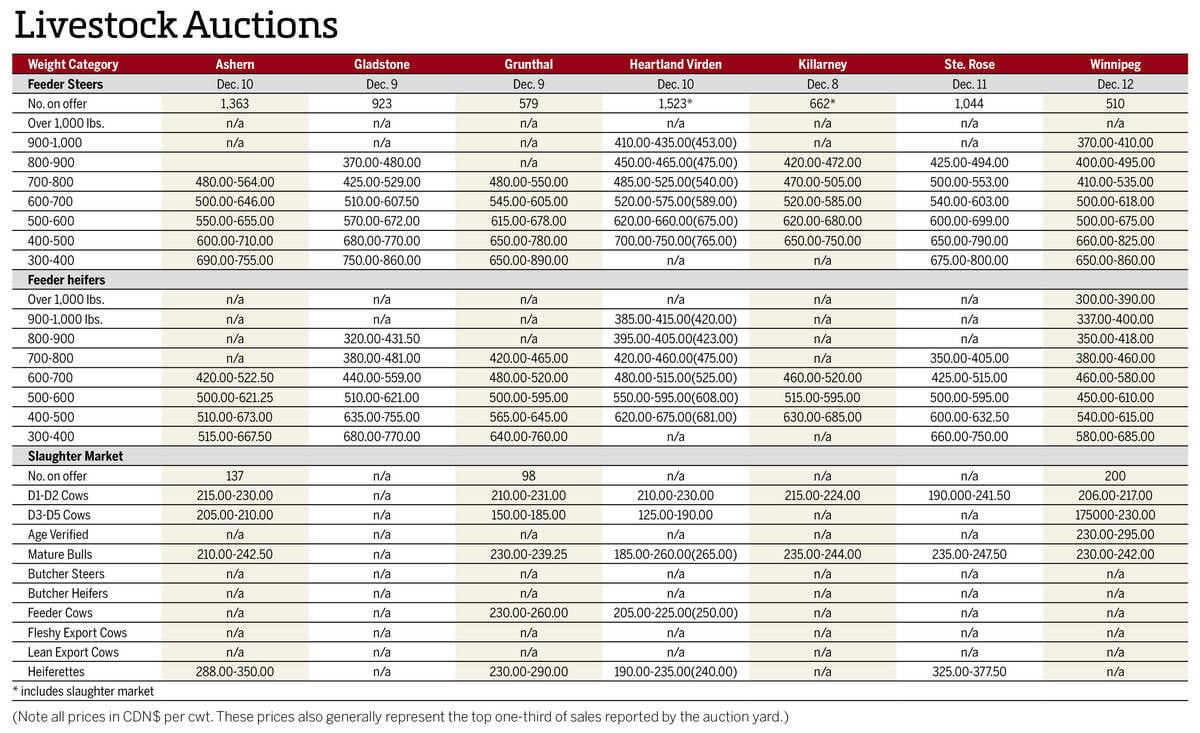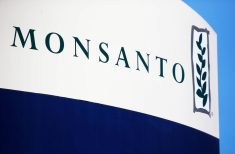It was May 2020, and the tone was grim as Canada’s beef and pork sectors pondered a sudden free fall in demand for live animals.
“Our figurative farmhouse is burning down,” then Canadian Pork Council president Rick Bergmann said on one Zoom call.
COVID-19 had led to major plant closures and slowdowns in both the U.S. and Canada. As of April 23 of that year, H@MS Marketing had estimated that 15 per cent of U.S. pork packing capacity was down. Hogs and beef cattle were backing up the supply chain.
Read Also

Manitoba cattle prices Dec. 16
Here’s what local farmers were getting paid last week for their cattle at Manitoba livestock auction marts; prices covering the week Dec. 8-12, 2025.
The pork industry was expecting hits of $30-$50 a head, those on the Zoom call heard. The isowean market had already crashed, sliding from about US$59.15 in January to just US$5.60 by April 23. Producers couldn’t find buyers.
The beef sector wasn’t doing much better.
Today, it’s tariff threats flying around, not viruses, but they just as effectively threaten to take the legs out of demand for Canadian livestock to the U.S., and some of the conversations are eerily the same.
Whenever there’s a significant market disruption, government aid usually comes up.
Market hardship from COVID-19 led government to invoke AgriRecovery, including, as our reporter Jeff Melchior recently reported in this issue, beef set-aside programs similar to those that followed BSE. Another $50 million in AgriRecovery aid was earmarked for the pork sector.
With tariffs still in limbo, it’s hard to say what aid asks might come out of the latest crisis.
In the pork sector, as Don Norman and Miranda Leybourne report, producers are already feeling impacts despite not a single tariff dollar being imposed yet. An uncertain future led to the suspension of forward contracts.
At the same time, Dickson Gould, president of The Progressive Group of Companies, says he doesn’t expect to see the same spiraling crash in isowean prices that was so alarming back in 2020.
Recent weeks have also seen a 2020-esque surge of interest in breaking down interprovincial trade barriers and support for local food systems.
In an article posted by CBC Feb. 6, Canada West Foundation CEO Gary Mar noted more interest in tearing down those barriers now than he’s seen in decades.
Another CBC article quoted federal Transport and Internal Trade Minister Anita Anand as saying that interprovincial trade barriers could be eliminated in the next month.
History proves that it won’t be that easy.
Meat, except from federally inspected abattoirs, is one commodity that has stayed stubbornly within provincial borders, despite the occasional push to harmonize regulations so smaller facilities could build their domestic market reach.
In May 2020, in an effort to ease strain on the value chain, the Canadian Food Inspection Agency put in a temporary exception that let meat from provincially inspected abattoirs cross provincial lines. The implementation, however, sparked questions. Then Manitoba Agriculture Minister Blaine Pedersen called it a “stop-gap,” noting the opacity of the process.
The same CBC article that noted the surge in interprovincial trade barrier discussion also noted that it’s not a new fight but, despite deals like the New West Trade Partnership between B.C. and the Prairie provinces, the issue hasn’t seen a lot of movement.
Manitoba Premier Wab Kinew was recently asked about interprovincial trade at Manitoba Ag Days earlier this year. His response was that, while internal trade is part of their strategy, “Manitoba is a leader there.
“So, you know, for us to see the benefits of internal trade, it would really be for a lot of the other provinces, I think, to do some work to address some of those trade barriers.”
If the work needs to be done, it’s hard to imagine a better time.
Likewise, with tariffs psychologically linked to Canadian sovereignty thanks to U.S. President Donald Trump’s “51st state” rhetoric, pleas from politicians and consumers alike to “buy local” are landing.
It’s another echo from the pandemic years. Local food manufacturers and direct marketing farms clocked more interest in their wares during that time. With more eyes on the farm and Canadian agribusinesses once again, there should be easy opportunity to invest in local and domestic food systems.
The crux will be making sure that growth sticks past the latest crisis, rather than sliding back into the status quo.
There will be no getting away from some level economic hurt if the U.S. makes good on its tariff threats, but giving Canadian industries every possible inch of alternative market, both local and regional, can only help damage control. It would also remove historic barriers that have long been a thorn in the side of domestic growth, but that have previously been sidelined by the huge pipeline that was U.S. trade.
















